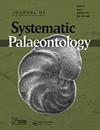The first evidence of Heosminthus from North America and the phylogenetics of Sminthidae (Mammalia, Rodentia, Dipodoidea): biogeographical implications
IF 2.2
2区 地球科学
Q3 EVOLUTIONARY BIOLOGY
引用次数: 0
Abstract
The Eurasian fossil record is rich with the remains of sminthid rodents, a clade today represented by a single genus, Sicista. In contrast, the North American record of the family is sparse and exclusively composed of species of Plesiosminthus, an animal bearing a grooved incisor, during the Oligocene. This fossil record is the product of dispersal events from Eurasia. We here present the first occurrence of a smooth-incisor sminthid from North America. The new species, Heosminthus teredens from the Arikareean-aged Cabbage Patch beds of Montana, represents a rare occurrence of cranial material showing the clear association between incisors and cheek teeth, and the first postcranial remains for fossil sminthids. Our phylogenetic analysis, expanding on prior work, shows that Heosminthus teredens is most closely related to Heosminthus borrae, from Mongolia. In combination with published radioisotopic dating, our phylogenetic framework of sminthids provides evidence for an additional dispersal of sminthid rodents from Eurasia to North America 30 million years ago via Beringia. Our morphometric analysis of the tibia and metatarsal supports a terrestrial ecology for the new species; it is possible the animal had limited scansorial and/or saltatorial abilities. The large sample size of teeth available for the new taxon enables an analysis of morphological variation and indicates a high degree of polymorphism as well as a large size variation, even when controlling for stratigraphical and geographical range. https://zoobank.org/urn:lsid:zoobank.org:pub:B7D4245C-992F-4956-96AD-10D7CFA8E5C8北美洲首次发现蠕虫和蠕虫科(哺乳动物、啮齿目、双足目)的系统发育学:生物地理学意义
欧亚大陆的化石记录中有大量的半人类啮齿动物的遗骸,这一分支今天以一个属Sicista为代表。相比之下,该科在北美的记录很少,而且在渐新世期间只由蛇颈龙属物种组成,蛇颈龙是一种门牙有凹槽的动物。这一化石记录是欧亚大陆扩散事件的产物。我们在这里介绍第一例来自北美的光滑门牙假牙。这一新物种,来自蒙大拿州Arikareean老化的卷心菜斑块床的圆鼻虫,代表了一种罕见的颅骨材料,显示出门牙和颊齿之间的明显联系,也是第一批化石化石的颅后遗骸。我们的系统发育分析,在先前工作的基础上扩展,表明圆线虫与来自蒙古的borrae线虫的亲缘关系最为密切。结合已发表的放射性同位素测年法,我们的小蚁类系统发育框架为3000万年前小蚁类啮齿动物从欧亚大陆经由白令纪进一步扩散到北美提供了证据。我们对胫骨和跖骨的形态计量学分析支持了新物种的陆地生态学;这只动物可能具有有限的扫描和/或跳跃能力。新分类单元的牙齿样本量大,可以分析形态变异,表明即使在控制地层和地理范围的情况下,也存在高度多态性和较大的尺寸变异。https://zoobank.org/urn:lsid:zoobank.org:pub:B7D4245C-992F-4956-96AD-10D7CFA8E5C8
本文章由计算机程序翻译,如有差异,请以英文原文为准。
求助全文
约1分钟内获得全文
求助全文
来源期刊
CiteScore
5.30
自引率
7.70%
发文量
31
审稿时长
>12 weeks
期刊介绍:
The Journal of Systematic Palaeontology publishes papers that provide novel and impactful results in phylogenetics and systematics and that use these results in ways that significantly advance rigorous analyses of palaeogeography, palaeobiology, functional morphology, palaeoecology or biostratigraphy. Papers dealing with theoretical issues or molecular phylogenetics are also considered if they are of relevance to palaeo-systematists. Contributions that include substantial anatomical descriptions, descriptions of new taxa or taxonomic revisions are welcome, but must also include a substantial systematics component, such as a new phylogeny or a revised higher-level classification. Papers dealing primarily with alpha-taxonomic descriptions, the presentation of new faunal/floristic records or minor revisions to species- or genus-level classifications do not fall within the remit of the journal.

 求助内容:
求助内容: 应助结果提醒方式:
应助结果提醒方式:


